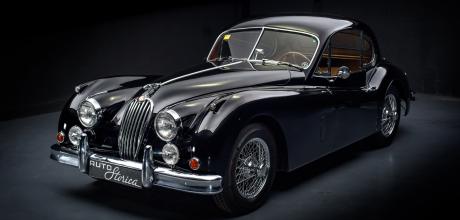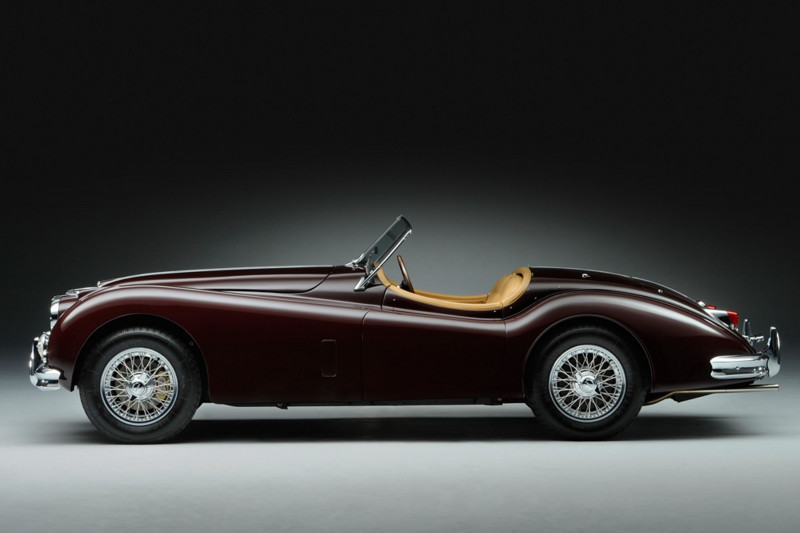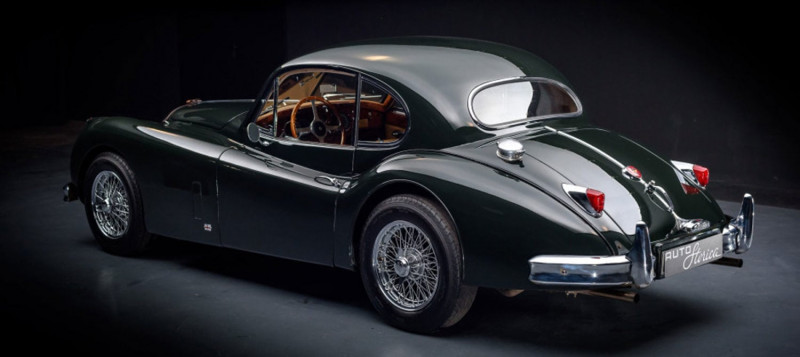Buying Guide Jaguar XK140

The XK140 shares the spirit of the original XK sports car but offers useful practical upgrades over the XK120. If you’ve got the funds, here’s what you need to know.
WORDS: PAUL GUINNESS
MIDDLE CHILD
The car with all the spirit of the original XK120 but some added convenience.
With the XK120 of 1948-1954 establishing Jaguar as a force to be reckoned with on the international sports car market, its shorter-lived successor – the XK140 – was designed to move the sector forward via an array of desirable upgrades. The newcomer was no less entertaining, of course, retaining Jaguar’s new-found reputation for power, performance and genuine driver appeal; but with some extra horsepower complemented by rack and pinion steering and improved suspension, the XK suddenly offered a touch more sophistication.

The XK140’s three-year production run inevitably meant fewer sales than its predecessor, with just 8937 examples finding buyers worldwide compared with the XK120’s production figure of just over 12,000. Factory-built right-hand drive models were particularly scarce thanks to Jaguar’s success in export markets, with only 1392 XK140s of all types having their steering wheels on the right.
Break those figures down further and you find that just 73 roadsters, 480 drophead coupés and 839 fixed-head coupés were built in right-hand drive form.
There’s less of a shortage of re-imported cars that have been converted to right-hand drive spec in more recent years (previous ‘barn find’ restoration projects from some of North America’s sunnier states), while plenty of other returnees to the UK retain their LHD layout. Either way, an XK140 makes a superb choice for the classic Jaguar fan seeking a sporting experience.
Neatly bridging the gap between the rawness of the XK120 and the relative modernity (thanks to its disc braking) of the XK150 was, of course, the XK140 of 1954-1957. This was the model that took all the best features of the original design and combined them with a host of useful upgrades. The 3442cc straight-six XK engine was improved via a high-lift camshaft, boosting output (by 10bhp) to an impressive 190bhp at 5500rpm in standard guise. And the XK140 also benefited from a revised close-ratio gearbox (with optional Laycock de Normanville overdrive), while in 1956 it became the first Jaguar sports car to be offered with automatic transmission.

Alford & Alder rack and pinion steering featured on the XK140, having been proven on the C-Type. Telescopic dampers took the place of lever-arm shock absorbers, helping to substantially improve the handling characteristics of this latest XK.
The newcomer’s aesthetics were also revised, though not dramatically. The chrome bumpers were larger than those fitted to the XK120, modern flashing indicators were introduced, and the grille was changed to incorporate fewer (but wider) vertical bars. Rather more useful as an upgrade, however, was the increase in interior space, with Jaguar’s decision to move the car’s firewall (and engine) forwards slightly resulting in three inches of extra legroom compared with the XK120.
As with its predecessor, XK140 buyers were offered three different body styles comprising a two-seater roadster with detachable windscreen frame, plastic side screens and a canvas hood; a drophead coupe with a more elaborate roof, winding windows and a fixed screen; and a fixed-head coupe for those who didn’t crave the open-air experience.
The FHC benefited from an extended roofline, enabling both it and the DHC to offer some extra space behind the seats, while the roadster’s scuttle and doors were two inches lower than on the XK120. To make the most of the extra legroom mentioned earlier (and to aid entry and exit), the doors on all models were lengthened; and to make the XK140 capable of carrying more luggage, the bulkhead between the boot and the cabin could now be folded down, enabling larger items to be loaded.
Although the standard transmission fitted to the XK140 was the familiar four-speed Moss unit (with overdrive as an extra-cost choice), automatic transmission arrived as an option in 1956. Your final choice of gearbox nowadays will depend as much on what’s available within your budget as on your own personal preferences. More important to the enthusiastic driver was the XK140’s availability in optional Special Equipment (or SE) guise, which brought with it a 9:1 compression ratio, twin exhaust pipes, stronger torsion bars and a tweaked Type C cylinder head – a combination that gave the SE an extra 20bhp and a top speed of up to 129mph. The SE also featured front fog lamps and wire wheels, although many XK140s have since been retro-fitted with these.
Whichever version of the XK140 you finally opt for nowadays, you should find that it offers numerous advantages over the XK120. Most XK140 owners seem to prefer its suspension design (its handling is noticeably improved over that of a standard XK120), and just about everyone agrees that the extra on-board space makes the car a whole lot more comfortable and usable. Before you start searching the classifieds, however, there are numerous points to bear in mind.
WHAT TO LOOK FOR
BODY
With the XK140’s chassis inevitably being based around that of the XK120, the same advice applies to both models when buying. The chassis itself is a sturdy design and tends to last well, but it has a list of rot-prone areas that includes the outriggers, anti-roll bar mountings and rear leaf spring mounts, all of which can be tricky and expensive to restore properly.
The good news for anyone thinking of taking on an XK140 that needs work is that chassis repair sections can be supplied, so talk to companies like Guy Broad, XK Engineering and SNG Barratt about your particular requirements. As ever though, it’s vital that you research the cost of any parts you’re likely to need before agreeing to buy a car that requires work. Given the high value of any member of the classic XK family, we’d recommend spending extra on a professional pre-purchase inspection by a marque expert, particularly if you’re buying from any source other than a respected specialist.
The XK140’s bodyshell and outer panels also bring plenty of potential when it comes to corrosion, with the entire structure needing careful examination. It’s as important to check for poor quality previous repairs as it is signs of rot; if the vendor claims that the car has been professionally restored and all issues dealt with, make sure you ask for detailed photographic proof of this.
Particular areas to focus on include the lower sections of the front and rear wings, the A and B-posts, the bottoms of the doors, the outer sills, the floor pans and the boot floor. If you’re buying an XK140 that has less than perfect panels, you at least have the reassurance of readily available replacements – although again, pre-purchase budgeting is essential. An XK140 door assembly from SNG Barratt will set you back around £3041 at the time of writing, with the same company charging about £1342 for an outer rear wing and £3825 for a front wing (without headlamp pods). It’s easy for the cost of bodywork restoration to spiral if you inadvertently buy a car needing attention.
ENGINE
The 3.4-litre XK straight-six fitted to the XK140 is reliable and durable, but inevitably requires regular maintenance if it’s to remain healthy. This includes regular oil and coolant changes, as any lack of antifreeze over a long period of time can cause internal corrosion. Does the car you’re buying come with plenty of paperwork to prove it’s been well looked after, or perhaps firm evidence of an engine rebuild at some point?
It’s important to check for blue smoke from the exhaust (particularly under acceleration), although sometimes this can be a sign of blockages in the breather system’s filter and pipework. A healthy oil pressure is essential, and you should also be on the lookout for engine oil leaks (often from the crankshaft’s rear oil seal). If the engine rattles excessively on start-up, it’s a sign that the timing chain is worn and in need of replacement – a job that’s labour-intensive and won’t come cheap.
TRANSMISSION
Most XK140s have the four-speed Moss manual gearbox mentioned earlier, which has no synchromesh on first gear. Worn synchro on the other gears isn’t unusual, with the layshafts and roller bearings also being prone to wear on high-mileage cars. If you’re inspecting an XK140 with automatic transmission, check for smooth gear changes; if it’s slow to change from second to third or you hear any scraping noises under acceleration, you should assume that the gearbox needs rebuilding.
SUSPENSION
When checking over any XK140, make sure it sits level when viewed in profile, as the rear end can suffer from sagging springs on wellused examples. When driving the car, does it feel sloppy or does it roll excessively during cornering? The XK140 generally handled better than the XK120 when new, and should still be relatively roll-free now, with reasonable ride quality by ’50s sports car standards. If it doesn’t feel ‘together’, then a potentially expensive suspension rebuild could be on the cards.
If you’re not a stickler for originality and you fancy improving the handling of your XK140, Guy Broad offers a front suspension upgrade kit that includes all new poly bushes and mounts, uprated AVO shock absorbers and a thicker antiroll bar, priced at around £715 including VAT. Or if you prefer to just change the dampers, you can buy the AVO adjustable shock absorbers separately at less than £125 each.
STEERING
The adoption of rack and pinion steering for the XK140 dramatically improved the feel of the car, adding extra precision compared with the previous set-up. If it feels worn, then you’re looking at replacing the steering rack, although reconditioned rack assemblies (complete with new bushes and bearings) are readily available on an exchange basis.
BRAKES
The standard all-drum braking system is simpler in design than the later XK150’s all-disc set-up, but obviously not as efficient – although the car should still pull up fairly promptly and in a straight line. If the brakes feel over-spongy or you can hear any rubbing noises when braking, the entire system is probably overdue an overhaul.
INTERIOR
Checking the state of any XK140’s interior is essential but no more complicated than with most classics of the same era. On a roadster or DHC, the state of the hood is an obvious consideration, particularly as any long-term leaks or signs of wear and tear will almost certainly have caused damage inside the car. The good news is that new hoods are available to order, with SC Parts charging from around £832 for a replacement hood for an XK140 DHC, with headlining adding around £265 to that.
If you’re buying an XK140 that’s in generally good condition but with an interior that’s past its best, there’s no shortage of help. BAS International (www.car-hood.co.uk), for example, sells individual items of trim for the XK140, from complete leather seat covers (at around £856 per pair) through to carpet sets (at £378) and leather door pulls (at just over £64 per pair). Or you can buy a complete interior refit kit, containing absolutely everything you need for a total refurbishment (down to the smallest trim pieces) from around the £3100 mark.
UPGRADES
There are plenty of modifications available for XK140 owners who appreciate the benefits of going ‘non-standard’, with a number of particularly tempting options out there. Guy Broad, for example, will sell you the Broadsport disc brake upgrade kit for less than £960, while owners of cars with the standard braking set-up might want to invest £306 in the same company’s dual-line brake master cylinder that ensures a 60/40 front to rear bias.
Anyone craving more power might be interested in the Broadsport race-spec cylinder head, said by Guy Broad to be ‘ready for the track’ thanks to its big valves, gas-flow work, porting, large cam followers, bronze valve guides and more – all for £2700 including VAT.
And the same company offers a triple Weber kit with ported manifold, yours for £1980 at the time of writing. Twyford Moors, and others, offer a front disc brake conversion kit, uprated suspension, power-steering kits and even five-speed gearbox conversions for your XK140, with prices varying according to your exact requirements and the extent to which you want your car enhanced. The sky is the limit really. Otherwise, an electric cooling fan gives peace of mind in traffic, while electronic ignition can boost reliability. Small cost, but a big change for a car used regularly.
VALUES
Prices for the XK140 vary widely according to the condition and history of each survivor, with completely numbers-matching cars inevitably commanding a premium. It’s not unusual to see such examples that are restored to concours standards being offered for sale at £130,000- £150,000. But a factory-built SE-spec XK140 or ultra-rare right-hand drive roadster (the dearest model in the range) can head towards the £200,000 mark when in perfect condition.
You can become the proud owner of an XK140 for substantially less, of course. Project cars start from around the £20,000-30,000 mark (though the cost of a professional restoration makes these a questionable choice), while a FHC in good to excellent condition should be achievable for between £60,000 and £80,000.
The Drophead Coupes tend to command more, with excellent cars priced from £90,000 (up to around £110,000 for a show car), with roadsters priced at £100,000-£130,000 in good order.
One of the XK140’s biggest advantages over its predecessor is improved legroom. Interior was more lavishly trimmed than the XK120. Uprated XK engine provides around 200bhp and very modern pace.
EV SAYS...
Andrew Evanson Senior Operations Manager at Lancaster Insurance Services, says:
“The XK140 offers all the charm of the XK120, with added user-friendliness.”
INSURANCE COSTS
Quotation supplied by Lancaster Insurance
1 1957 Jaguar XK140 coupe 3.4, value £60,000 £82.20 or £100.20 with Agreed Value
2 Based on 45-year old, with a second vehicle. It’s garaged, covers 3000 miles a year and lives in an SP2 postcode. They have no claims or convictions, are a club member, and are employed as a marketing manager.
Disclaimer: Policy benefits, features and discounts offered may vary between insurance schemes or cover selected and are subject to underwriting criteria. An additional charge may be payable.
3 Subject to underwriting criteria.
www.lancasterinsurance.co.uk 01480 809176
OR MAYBE..?
Paul Wager, Group Editor Austin-Healey 3000
As you can read elsewhere in this issue, a recent chance to revisit the Big Healey proved how close in spirit it is to cars of an earlier time than the late-model BJ8 we featured – namely, the 1950s Jaguar XK. The Healey may lack the technical sophistication of the XK140 but on the road it's a worthy opponent and no less stylish either. Like the Jaguar, the Healey isn't exactly cheap but it remains usefully less costly.
Dave Youngs, Lancaster Insurance Jaguar XK150
The purists in search of the original XK experience will value the XK120 most highly, which has naturally driven the values up, with the very similar-looking XK140 close behind. The third evolution of the formula, the XK150 remains usefully more affordable but in many ways is the better car to drive and the easier to own, particularly if you're new to cars of this era. You certainly won't be disappointed.
| SPECIFICATIONS | |||
| MODEL | XK140 OTS | XK140 FHC | XK140 DHC |
| ENGINE | 3442cc | 3442cc | 3442cc |
| MAX POWER | 210bhp | 210bhp | 190bhp |
| MAX TORQUE | 213lb.ft | 213lb.ft | 210lb.ft |
| TRANSMISSION | 4sp O/D man | ||
| BRAKES | Discs front, drums rear | ||
| LENGTH | 4.4m | ||
| WIDTH | 1.6m | ||
| HEIGHT | 1.4m | ||
| KERB WEIGHT | 1422kg | 1461kg | 1397kg |
| MAX SPEED | 119mph | 129mph | 120mph |
| 0-62 MPH | 8.4 secs | 11.0 secs | 11.0 secs |

